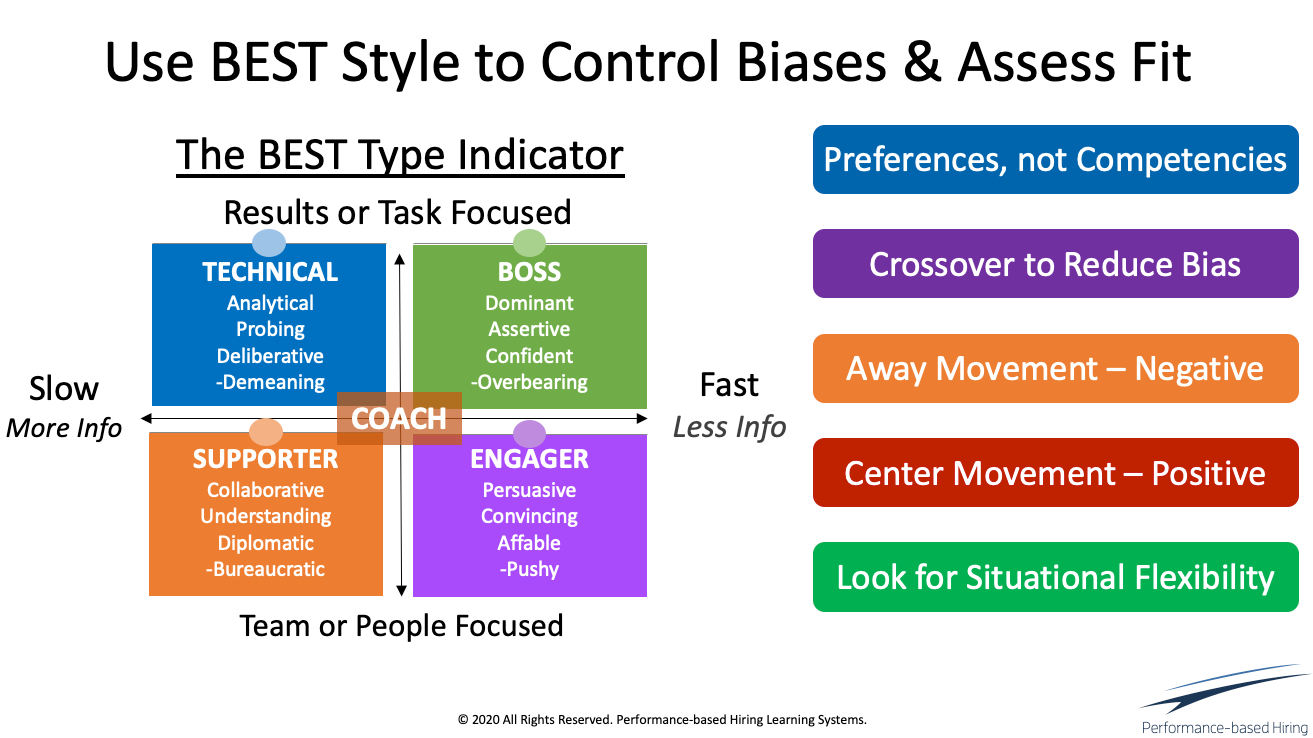Back in the ‘80s I took my first DiSC personality assessment and its cousin, the Predictive Index (PI). These types of assessments involve a series of either/or questions like, “Would you rather attend a beer bust or do root cause analysis?” Both tests concluded I liked to persuade people with a hammer and that I was a weak analyst.
But they were both wrong. While I prefer to party and argue, my core competency is detailed analytics.
Worse than the fact that these tests measure preferences, not competencies, they also don’t consider the idea that the strongest people can modify their preferred style based on the needs of the situation. These serious flaws cause too many false positives and false negatives to make them useful for screening candidates before they’re interviewed.
Despite these misgivings, they are useful for assessing the 3-4 finalists for a job. This helps to better understand how a person’s style impacted their performance either positively or negatively.
Interviewers Should Take the BEST Test Before Candidates Do
Over the years I created a free 30-second condensed version of these assessments calling it the BEST test. Not only is it useful for assessing candidates, it’s even better when interviewers take it before interviewing candidates to help expose and neutralize their biases during the interview.
To see how this works, put yourself on the right side of the 2X2 BEST matrix if you prefer to make quick decisions and on the left if you’re more cautious. Assign yourself to the top half if you tend to focus more on results than people and on the bottom half if the reverse is true. Based on this analysis you’re either a Boss, Engager, Supporter or Technical.

Increase Interview Accuracy by Becoming Your Least BEST
In general, people are more comfortable with those who have similar styles. From a BEST standpoint this means their dominant BEST style and the two adjacent styles. People have the most conflict with their least-BEST style – their diagonal opposite. However, by adopting the attributes of this opposite style during the interview, it’s possible to become more objective by evaluating the candidate’s accomplishments through a totally different point of view.
Some examples will help explain this reverse thinking:
- The Boss: By listening more before judging a candidate’s answers and asking about team projects the Boss can be more like a Supporter.
- The Supporter: Getting lots of metrics and details about the results the candidate has achieved allows a Supporter to become Boss-like.
- The Engager: Engagers can become like Techies by digging into the process the candidate used to achieve results rather than making instant decisions on personality.
- The Technical: Techies can become Engagers by shifting their emphasis from determining technical brilliance to finding out how the person collaborated and influenced people on their team projects to achieve results.
This crossover technique is a good way to temporarily move towards the center of the graphic – the Coaching position – to increase assessment accuracy. Coaches are the people who naturally see all sides of an issue before they make decisions, so this crossover approach is a great way to become more objective.
Assess Team Skills by Observing Changes in BEST Type Over Time
With this more objective mindset, you can find candidates with stronger team skills by determining if they move to the coaching position when they’re trying to fully understand all sides of an issue and whether this movement is situational or permanent.
One way to do this is to ask candidates to give detailed examples of different team accomplishments over the past few years. As part of this, get examples of decision-making, problem-solving and handling conflict where different BEST styles were needed to fully understand the situation and develop the best outcome. After a few accomplishments at different periods in time, you’ll see patterns emerge revealing whether the candidate modified his/her dominant BEST style to meet the needs of the situation or uses a “one size fits all situations” approach. Raise the caution flag high when you see people who are this one-sided or who become more extreme in their natural style.
Use the BEST Test to Confirm Rather Than Predict
BEST and similar personality type indicators have their good and bad points. Since they only assess preferences, not competencies, these tests should not be used for screening candidates before they’re interviewed. However, it is appropriate to use these types of tests for the short-list of finalists to determine how they adopt their natural style based on the circumstances. More important is for interviewers to take this test ahead of time to override their natural decision-making approach to evaluate candidates more objectively. This is actually the BEST way to improve interviewing accuracy and hire the right person for the right reasons.


